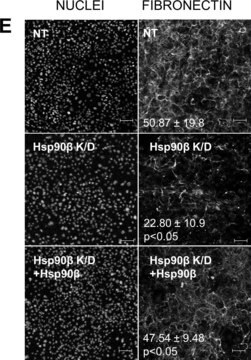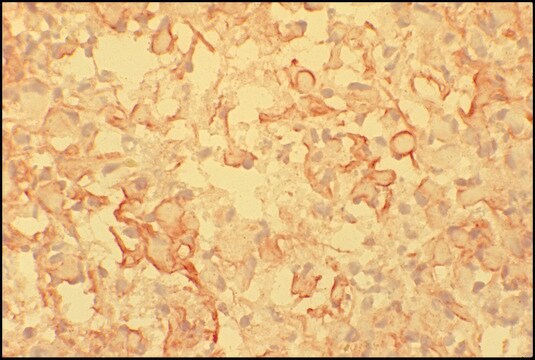Key Documents
SAB4200760
Anti-Fibronectin antibody, Mouse monoclonal
clone FN-15, purified from hybridoma cell culture
Synonim(y):
Anti-CIG, Anti-Cold-insoluble globulin, Anti-FN
About This Item
Polecane produkty
pochodzenie biologiczne
mouse
Poziom jakości
forma przeciwciała
purified from hybridoma cell culture
rodzaj przeciwciała
primary antibodies
klon
FN-15, monoclonal
Postać
buffered aqueous solution
masa cząsteczkowa
220-260 kDa
reaktywność gatunkowa
human, mouse
stężenie
~1 mg/mL
metody
immunoblotting: 0.3-0.6 μg/mL using human fetal fibroblast-like WI-38 cell line extract
immunofluorescence: 2.5-5 μg/mL using human foreskin fibroblast Hs68 cells
immunohistochemistry: suitable
immunoprecipitation (IP): suitable
indirect ELISA: 0.15-0.3 μg/mL using 5 μg/mL Fibronectin from human plasma for coating
izotyp
IgG1
numer dostępu UniProt
Warunki transportu
dry ice
temp. przechowywania
−20°C
docelowa modyfikacja potranslacyjna
unmodified
informacje o genach
human ... FN1(2335)
Opis ogólny
Specyficzność
Immunogen
Zastosowanie
Działania biochem./fizjol.
Postać fizyczna
Inne uwagi
Nie możesz znaleźć właściwego produktu?
Wypróbuj nasz Narzędzie selektora produktów.
Kod klasy składowania
10 - Combustible liquids
Klasa zagrożenia wodnego (WGK)
WGK 3
Temperatura zapłonu (°F)
Not applicable
Temperatura zapłonu (°C)
Not applicable
Certyfikaty analizy (CoA)
Poszukaj Certyfikaty analizy (CoA), wpisując numer partii/serii produktów. Numery serii i partii można znaleźć na etykiecie produktu po słowach „seria” lub „partia”.
Masz już ten produkt?
Dokumenty związane z niedawno zakupionymi produktami zostały zamieszczone w Bibliotece dokumentów.
Klienci oglądali również te produkty
Nasz zespół naukowców ma doświadczenie we wszystkich obszarach badań, w tym w naukach przyrodniczych, materiałoznawstwie, syntezie chemicznej, chromatografii, analityce i wielu innych dziedzinach.
Skontaktuj się z zespołem ds. pomocy technicznej








